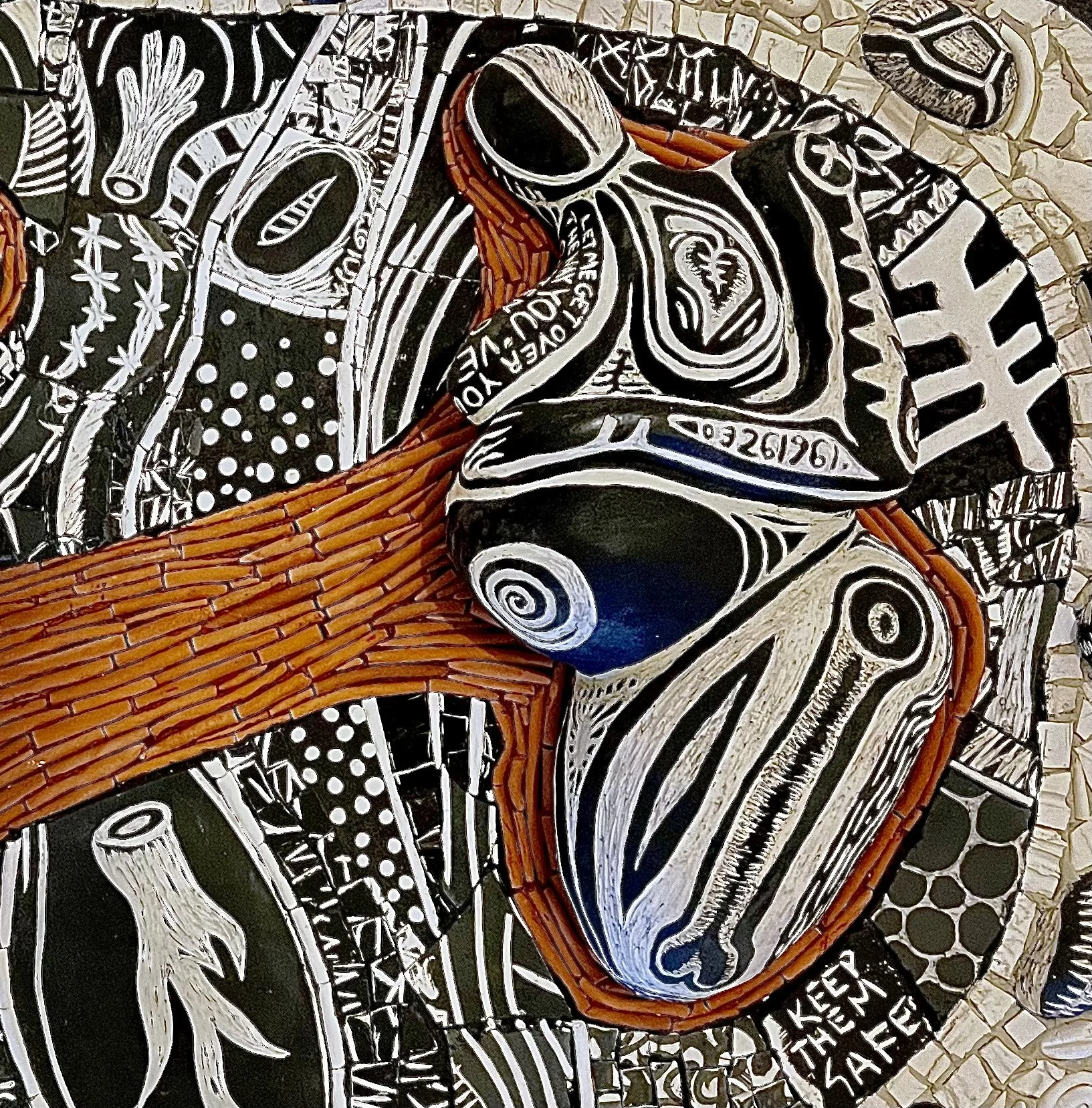Moving towards the light….
…after almost four years of wading through mud and self-doubt and regret and false pathways, which I now understand to be life as a PhD researcher.
Why would anyone spend their entire life making things that nobody can use and most people might not understand, a vocation that won’t make you much, if any, money and is considered impractical as a consistent, passionate focus of one’s life? Passion is almost never practical, and I never had a choice when it came to art. It has been part of my identity when all other labels, such as mother, daughter, adoptee, or jew, were confusing but art was not confusing- challenging yes but not confusing.
Philosopher Theodore Adorno says art is a riddle- it expresses something while hiding it. He also says that the task of art is to bring chaos into order. My work is about bringing chaos into order through mosaic, or what I define as mosaic.
Rant on Mosaic:
Like identity, mosaic is not just one thing; it is many things—drawing, sculpture, carving, writing—that are used together to express a whole idea. Identifying my work as mosaic has been and remains problematic, not only due to preconceived notions of what qualifies as a mosaic but also the association to the majority of mosaic makers today- fabricators, hobbyists, and generally- amateur artists who don’t understand art first. Yes, yes, I am the founder of The Chicago Mosaic School, and I am proud that our educational community has begun to transform perceptions of mosaic to inspire possibilities of mosaic through practice-oriented art education. There a very few artists that are practicing and experimenting to take the mosaic process to new heights. I would encourage you to head to Edgewater to GoCM to see the works of Etty Hasak, Casey Van Loon, and Sue Coombs, who have formally studied and practiced this art form and are breaking new ground through experimentation and innovation. I have been specific about which mentors I have chosen to work with; they are passionate, serious art teachers and practitioners who continue to study and practice art as their life’s work.
Yet there is a mosaic movement—not just here in the US but in Europe and Australia as well. Mosaic is celebrated primarily as a pictorial fabrication of an image, as a decorative approach to using and recycling traditional mosaic materials, as well as kitsch objects, as a method to copy patterns, styles, and subject matter from photos from other artists’ artworks. In most cases, the ‘original’ works are abstract- yet abstracted from what? What are you trying to get at? I am happy that so many have found the process of mosaic-making so appealing; I hope that people who love mosaic will discover that art is a language that can be used to speak things that cannot be told any other way. And it is here that I am intending to redefine mosaics as a fine art form, separate from a method for covering surfaces or replicating flowers or birds in shiny materials. Making art is an act of discovery and experimentation. What do you know and how can you say it and why do you choose to say it this way?
I define mosaic as an interdisciplinary practice of brokenness, chaos, and repair. This definition describes the physical process of creating as well as the methodology that can be used to develop and explore an idea. I am excited by the vast possibilities of expressing ideas through the mosaic medium and the unique and meticulous process that separates it from other disciplines.
Deconstructing, breaking, tearing, and cutting are commonalities between mosaic and collage, destruction as a mode of creation. Interdisciplinary, material-oriented practices exist within perceptions of modern art amongst the ever-present modern art versus craft debate. Mosaic-based art, like ceramics and fiber arts, is expanding perceptions of material, functional, technique, and process-driven mediums. “Craft is the skillful manipulation of technique, and art is the skillful manipulation of ideas,” and Professor Anne Wilson named the intersection of the two ‘sloppy craft’. This approach to masterful manipulation and understanding of materials and techniques is combined with “de-skilling.” Denis Longchamp defines the crossover from perfectionism or craft to the deconstruction of perfection, which is visual art: “ A ‘deskilling’ occurs when artists distance themselves from the technical mastery of their craft medium and engage in a new practice of re-skilling by which they express the critical content of their work.”. I agree that the outcome of the process can dispel underlying unspoken, implicit assumptions, ideas, and frameworks of craft-oriented mediums. Recent museum exhibitions have featured the works of interdisciplinary visual artists like Nick Cave, El Anitsui, Faith Ringold, Bisa Butler, and Shahzia Sikander, to name a few. The interplay of materials and techniques breaks from conventional approaches to visual language by incorporating components that already have an existing identity and meaning to the artist.
How is mosaic a visual strategy to unify and integrate fragmented identities through autoethnographic feminist narratives? The response of making is an act of bearing witness to suffering and cruelty using auto-theoretical narratives. Art-making is an investigative mechanism for delving into the profound impact of ancestral displacement on the post-holocaust generation. Mosaic art, as an interdisciplinary visual and narrative strategy, unites and empowers fragmented identities through the lens of feminist perspectives. There. I finally know.
